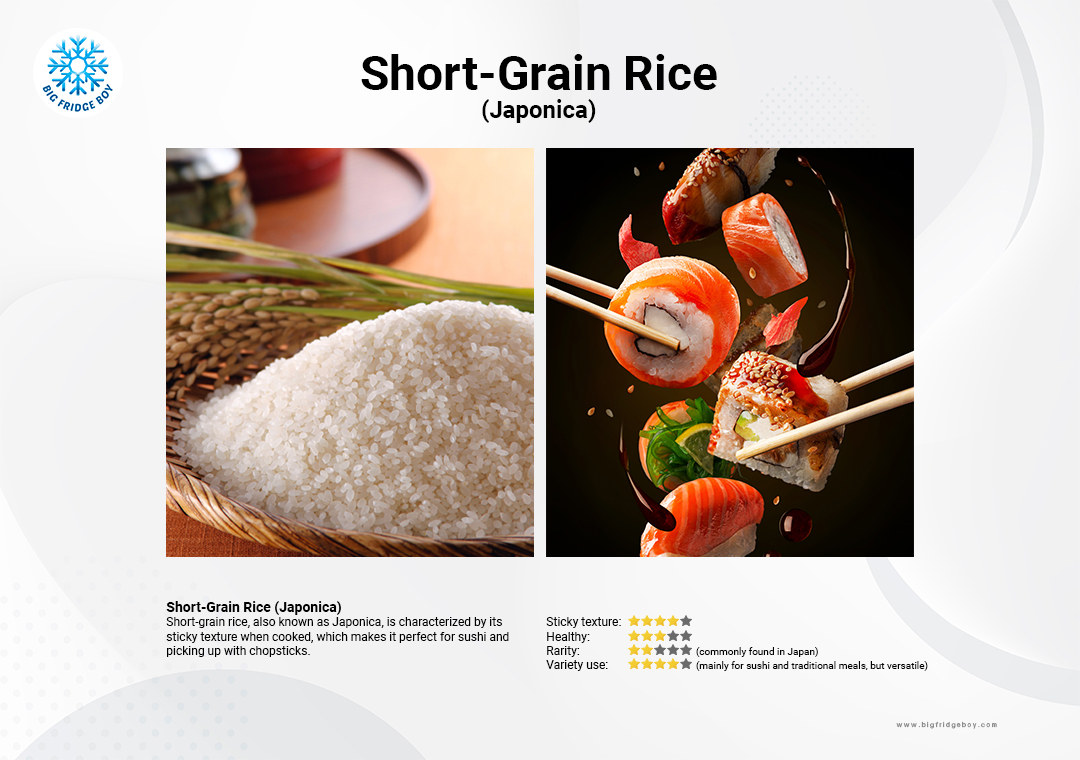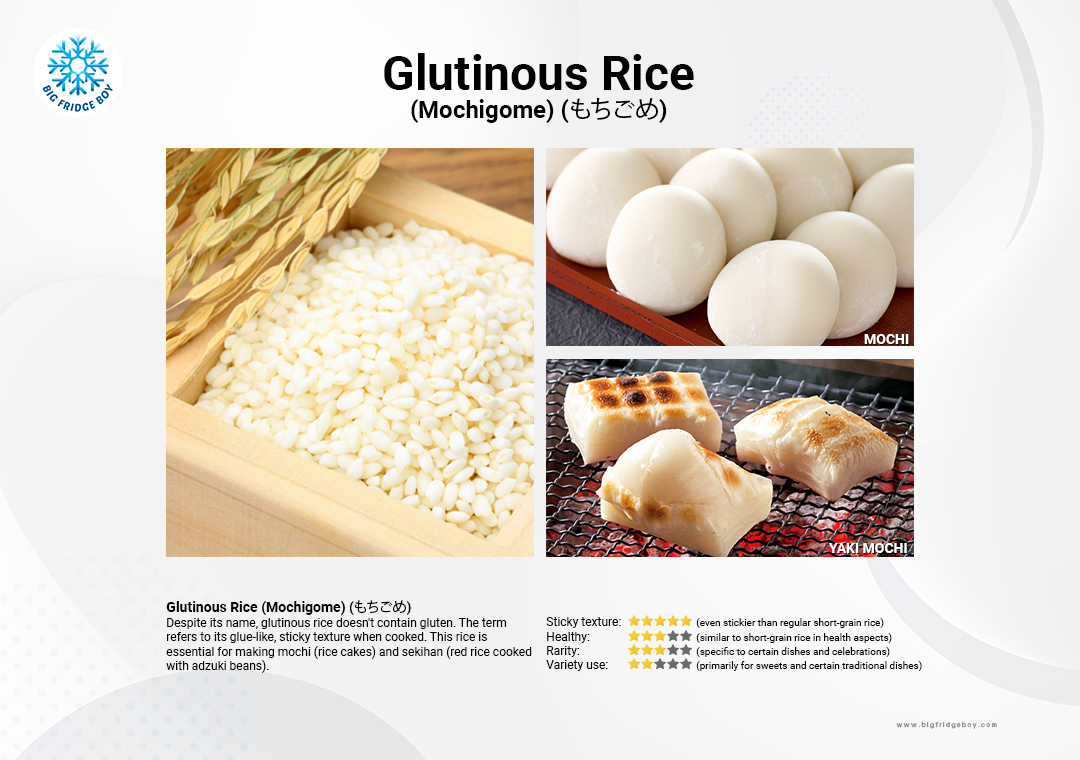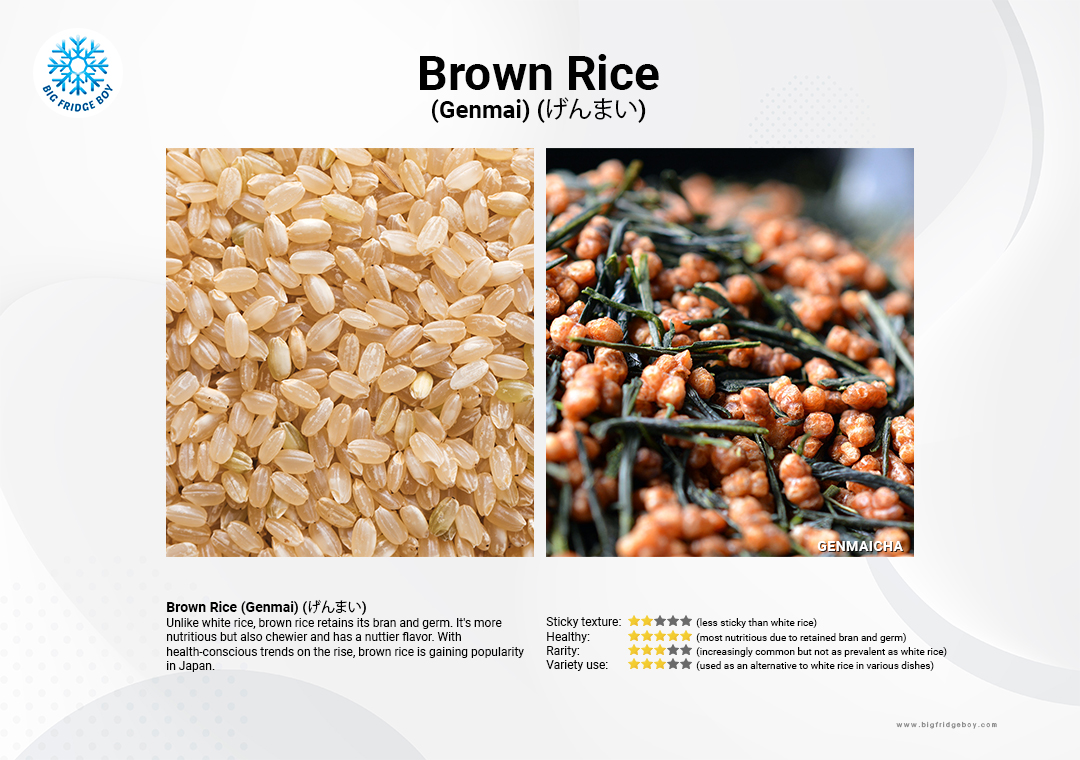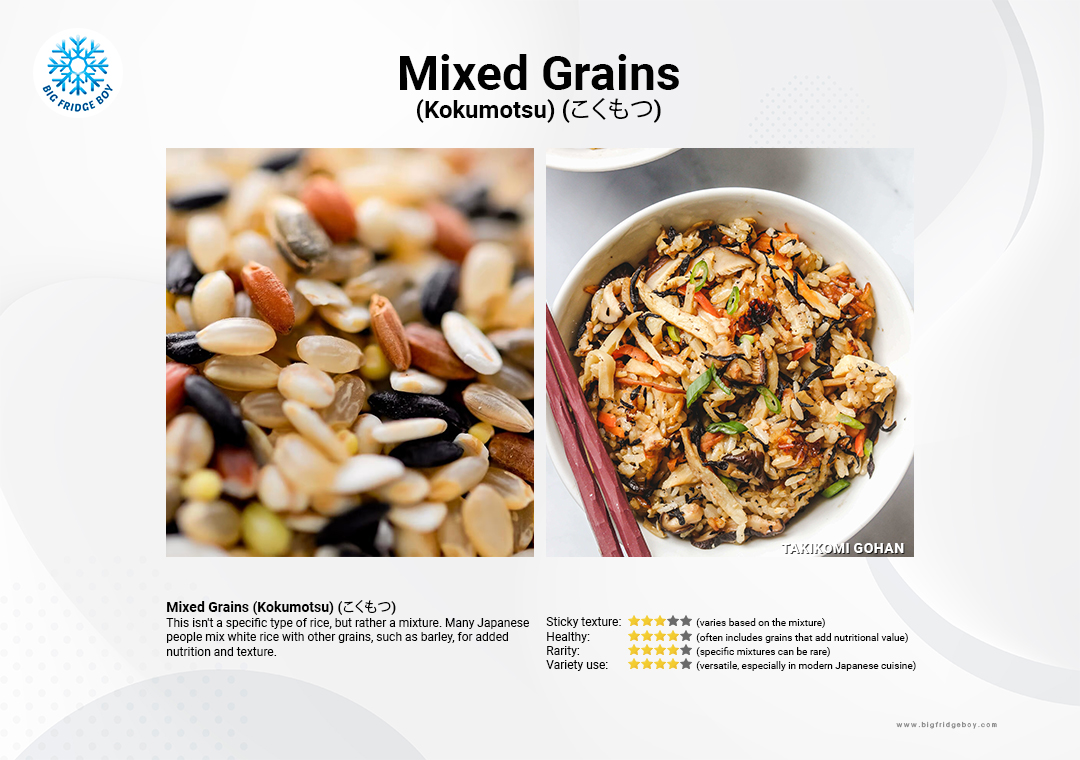“4 Japanese Rice Types to Know"
Last updated: 11 Oct 2023 | 5185 Views |

Japanese rice plays a central role in the country's culinary and cultural identity. While there are many varieties grown and consumed, they can generally be grouped based on grain size and purpose. Here's a deeper dive into the main types.

1. Short-Grain Rice (Japonica)
Short-grain rice, also known as Japonica, is characterized by its sticky texture when cooked, which makes it perfect for sushi and picking up with chopsticks.
Sticky texture: 4/5
Healthy: 3/5
Rarity: 2/5 (commonly found in Japan)
Variety use: 4/5 (mainly for sushi and traditional meals, but versatile)
- Koshihikari (こしひかり)
One of the most famous and premium varieties. Grown in several regions, including Niigata, it is known for its sweet flavor and sticky texture.- Origin: Koshihikari was first cultivated in 1956, a product of crossbreeding strains in Japan. The name draws from the historical Koshi Province, which includes parts of modern-day Niigata, a region famous for its high-quality rice due to its ideal climate and water sources.
- Characteristics: Known for its balanced flavor, delicate sweetness, and sticky texture. It has a translucent quality when uncooked, and a shiny appearance when cooked.
- Usage: Ideal for sushi, onigiri (rice balls), and as a side dish for traditional Japanese meals.
- Trivia: Often referred to as the "king of rice" due to its superior taste and texture. The name can be translated as "the light of Koshi," referring to the ancient Koshi Province where it originated. Many regions grow Koshihikari rice, but Niigata's version is especially famous and often considered the best.
- Origin: Koshihikari was first cultivated in 1956, a product of crossbreeding strains in Japan. The name draws from the historical Koshi Province, which includes parts of modern-day Niigata, a region famous for its high-quality rice due to its ideal climate and water sources.
- Sasanishiki (ささにしき)
A variety with a slightly less sticky texture than Koshihikari. It's popular in Miyagi Prefecture.- Origin: Developed in the mid-20th century, Sasanishiki became especially popular in the 1980s. It's a product of Miyagi Prefecture.
- Characteristics: Known for its good water absorption and retention, leading to a pleasant mouthfeel. It's less sticky and more resistant to cold, making it suitable for northern regions.
- Usage: Commonly used in onigiri (rice balls) because of its slightly less sticky texture.
- Trivia: Its popularity faced a decline after a colder season in 1993 damaged crops but has been regaining its place in the market.
- Origin: Developed in the mid-20th century, Sasanishiki became especially popular in the 1980s. It's a product of Miyagi Prefecture.
- Hitomebore (ひとめぼれ)
Originating from Miyagi Prefecture, this variety is slightly stickier than Sasanishiki but less so than Koshihikari.- Origin: Developed in Miyagi Prefecture in the 1990s as a cross between Koshihikari and another variety called Akita 64.
- Characteristics: Slightly stickier than Sasanishiki but less so than Koshihikari. Offers a balanced combination of sweetness and umami.
- Usage: Versatile for various dishes, including sushi and donburi (rice bowls).
- Trivia: The name translates to "love at first sight."
- Origin: Developed in Miyagi Prefecture in the 1990s as a cross between Koshihikari and another variety called Akita 64.
- Akitakomachi (あきたこまち)
As the name suggests, it's a specialty of Akita Prefecture. It has a texture and flavor profile similar to Koshihikari.- Origin: Derived from the Koshihikari strain, it's native to Akita Prefecture.
- Characteristics: Similar in flavor and texture to Koshihikari, with slight regional variations. Grains tend to be plump and have a desirable stickiness.
- Usage: Suitable for a wide range of dishes including sushi, onigiri, and donburi (rice bowls).
- Trivia: The name "Komachi" refers to Ono no Komachi, a famous poet from Akita known for her beauty. It's a nod to the rice's appealing characteristics.
- Origin: Derived from the Koshihikari strain, it's native to Akita Prefecture.

2. Glutinous Rice (Mochigome) (もちごめ)
Despite its name, glutinous rice doesn't contain gluten. The term refers to its glue-like, sticky texture when cooked. This rice is essential for making mochi (rice cakes) and sekihan (red rice cooked with adzuki beans).
Sticky texture: 5/5 (even stickier than regular short-grain rice)
Healthy: 3/5 (similar to short-grain rice in health aspects)
Rarity: 3/5 (specific to certain dishes and celebrations)
Variety use: 2/5 (primarily for sweets and certain traditional dishes)
- Origin: Glutinous rice has been cultivated throughout Asia for thousands of years. In Japan, its history goes back to ancient times, playing a significant role in both daily diets and festive occasions.
- Characteristics: The name "glutinous" refers to its sticky texture when cooked, but it doesn't contain gluten. The grains are opaque and shorter than typical short-grain rice. When cooked, mochigome becomes quite sticky and stretchy.
- Usage: It's the primary rice used for making traditional Japanese rice cakes or "mochi". Other uses include "sekihan" (red rice cooked with adzuki beans) traditionally made during celebrations, and "zoni" (a soup with mochi) consumed during the New Year.
- Trivia: Mochigome is central to many festivals in Japan. For example, during the "mochitsuki" tradition, families or communities come together to pound mochigome into mochi using large wooden mallets and a mortar, celebrating the New Year.

3. Brown Rice (Genmai) (げんまい)
Unlike white rice, brown rice retains its bran and germ. It's more nutritious but also chewier and has a nuttier flavor. With health-conscious trends on the rise, brown rice is gaining popularity in Japan.
Sticky texture: 2/5 (less sticky than white rice)
Healthy: 5/5 (most nutritious due to retained bran and germ)
Rarity: 3/5 (increasingly common but not as prevalent as white rice)
Variety use: 3/5 (used as an alternative to white rice in various dishes)
- Origin: Brown rice is simply white rice that retains its bran and germ. It's not exclusive to Japan but is grown wherever rice is cultivated.
- Characteristics: Brown rice has a nuttier flavor and chewier texture compared to white rice. It’s characterized by the outer bran layer that gives it its distinct color and increased nutritional value.
- Usage: Traditionally, brown rice was not as popular as white rice in Japan, but with increasing health consciousness, it’s being used in modern Japanese meals, served as a healthier alternative to white rice. It's also used in "genmaicha," a blend of green tea with roasted brown rice.
- Trivia: While brown rice was once considered peasant food in Japan, it’s now recognized for its health benefits, being rich in dietary fiber, vitamins, and minerals. The recent "slow food" movement in Japan has spurred a renewed appreciation for genmai's rich, natural flavor.

4. Mixed Grains (Kokumotsu) (こくもつ)
This isn't a specific type of rice, but rather a mixture. Many Japanese people mix white rice with other grains, such as barley, for added nutrition and texture.
Sticky texture: 3/5 (varies based on the mixture)
Healthy: 4/5 (often includes grains that add nutritional value)
Rarity: 4/5 (specific mixtures can be rare)
Variety use: 4/5 (versatile, especially in modern Japanese cuisine)
- Origin: The practice of mixing grains has ancient roots. In Japan, adding other grains to rice was historically done during times of scarcity or for health reasons.
- Characteristics: The specific characteristics depend on the mixture. Typically, mixtures might include barley, millet, or even beans. The result is a varied texture and often a more nuanced flavor profile.
- Usage: Mixed grains are often consumed for added nutrition or to bring a different texture to a meal. They might be used in dishes similar to those made with white rice, such as mixed rice dishes ("takikomi gohan") or rice porridge ("okayu").
- Trivia: During WWII and the post-war era, rice was scarce, leading many in Japan to mix their rice with barley. While this was done out of necessity, it introduced a generation to the nutty flavor of barley-mixed rice, a taste many older Japanese people still have a fondness for.
The primary type of rice grown and consumed in Japan is Japonica, specifically the short-grain varieties. Its stickiness makes it easy to eat with chopsticks and suitable for dishes like sushi. Over centuries, various regions in Japan have developed their own prized varieties, each with its unique taste and texture profile, shaped by the local climate, soil, and cultivation techniques.








